G2063
Soybean Aphid Management in Nebraska
Learn about the soybean aphid, its identification, life cycle, and damage, as well as how to scout and manage it. Photos of different stages and natural enemies are included.
Tom E. Hunt, Extension Entomology Specialist
Keith J. Jarvi, Extension Educator
Wayne J. Ohnesorg, Extension Educator
Lanae M. Pierson, Entomology Graduate Research Assistant
- Soybean Aphid Description
- Soybean Aphid Life Cycle
- Soybean Aphid Natural Enemies
- Soybean Aphid Injury to Soybean
- Soybean Aphid Occurrence in Nebraska
- Soybean Aphid Management
- Host Plant Resistance
- Resources
- Acknowledgments
The soybean aphid (Aphis glycines) was introduced into the U.S. in 2000 and first found in Nebraska in 2002. Yield losses of over 30 percent have been documented in northeast Nebraska and over 40 percent in others areas of the north central United States.
Soybean Aphid Description
The soybean aphid is soft bodied, light green to pale yellow, less than 1/16 inch long, and has two black-tipped cornicles (cornicles look like tailpipes) on the rear of the abdomen (Figure 1). It has piercing-sucking mouthparts and typically feeds on new tissue on the undersides of leaves near the top of recently colonized soybean plants (Figure 2). Later in the season the aphids can be found on all parts of the plant, feeding primarily on the undersides of leaves, but also on the stems and pods. The soybean aphid is currently the only aphid in North America that forms colonies on soybean.
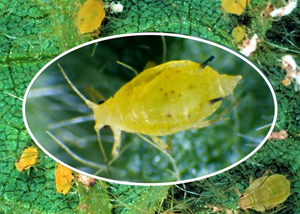 |
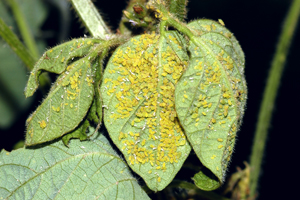 |
|
| Figure 1. Soybean aphids with black tipped cornicles. (All figures by James A. Kalisch, University of Nebraska–Lincoln Department of Entomology) | Figure 2. Soybean aphids on the bottom of upper soybean leaflets. (Source: James A. Kalisch, UNL) |
Soybean Aphid Life Cycle
The seasonal life cycle of the soybean aphid is complex with up to 18 generations a year. It requires two species of host plant to complete its life cycle, common buckthorn (Rhamnus cathartica) and soybean. Common buckthorn is a woody shrub or small tree and is the overwintering host plant of the aphid. Soybean aphids lay eggs on buckthorn in the fall. These eggs overwinter and hatch in the spring, giving rise to wingless females. These females reproduce without mating, producing more females. After two or three generations on buckthorn, winged females are produced that migrate to soybean. Multiple generations of wingless female aphids are produced on soybeans until late summer and early fall, when winged females and males are produced that migrate back to buckthorn, where they mate. The females lay eggs on buckthorn, and the eggs overwinter, completing the seasonal cycle. Nebraska lacks significant and widespread buckthorn populations, so early season soybean colonization by aphids migrating from buckthorn appears to be limited.
Soybean aphid populations can grow to extremely high levels under favorable environmental conditions. Reproduction and development is fastest when temperatures are between 70°F and approximately 85°F. Aphid numbers can change rapidly. (Populations can double in two to three days.) They do not do well when temperatures are in the 90s, and are reported to begin to die when temperatures reach 95°F. When temperatures drop below 48°F, development stops.
When populations reach high levels during the summer, winged females are produced that migrate to other soybean fields. Like a number of other insect species (e.g., potato leafhopper), these migrants can be caught up in weather patterns, moved great distances, and end up infesting fields far from their origin. Summer migrants likely are the major source of infestations in Nebraska.
Soybean Aphid Natural Enemies
There are many soybean aphid predators. The most visible predator is the multicolored Asian lady beetle (Figures 3 and 4), but the tiny (1/10 inch long), insidious flower bug (Orius insidiosus) is the most important predator. Naturally occurring predators, primarily the insidious flower bug, can significantly slow soybean aphid population growth, particularly during Nebraska’s hot July weather. Resident populations of predators also help reduce the rate of successful colonization of soybeans by the soybean aphid. Other common predators include green lacewing (Chrysoperla spp.) (Figure 5), brown lacewing (Hemerobius spp.), and damsel bugs or Nabids (Nabis spp.), among others.
Other groups of natural enemies include parasitoids and pathogens. The presence of aphid “mummies” (light brown, swollen aphids) indicates the presence of parasitoids (Figure 6). These mummies harbor immature parasitoids, which will become adults, emerge from the mummy, and parasitize more aphids. The presence of “fuzzy” aphid carcasses indicates fungal pathogens are present, which occasionally can lead to dramatic reductions of aphid populations. Although these organisms appear to play a minor role in soybean aphid population regulation, they may become more prevalent and important to aphid population regulation and management in the future.
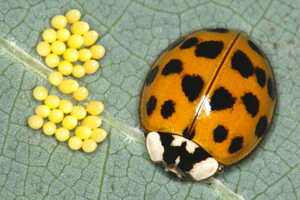 |
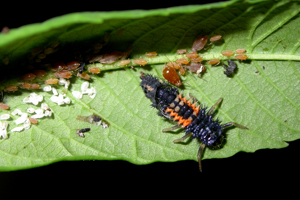 |
|
| Figure 3. Multicolored Asian lady beetle adult and eggs. (Source: James A. Kalisch, UNL) | Figure 4. Multicolored Asian lady beetle larva. (Source: James A. Kalisch, UNL) | |
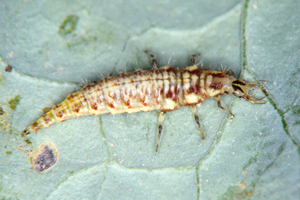 |
 |
|
| Figure 5. Green lacewing larva. (Source: James A. Kalisch, UNL) | Figure 6. Soybean aphids and parasitized aphid “mummies.” (Source: James A. Kalisch, UNL) |
Soybean Aphid Injury to Soybean
Soybean aphids injure soybeans by removing plant sap with their needle-like mouthparts and causing a reduction of photosynthesis. Symptoms of soybeans infested by soybean aphid may include yellowed, distorted leaves and stunted plants. A charcoal-colored residue also may be present on the plants. This is sooty mold that grows on the honeydew that aphids excrete. Honeydew by itself makes leaves appear shiny. Soybean plants appear to be most vulnerable to aphid injury during the early reproductive stages.
Soybean Aphid Occurrence in Nebraska
Soybean aphids have been reported in most soybean-producing regions of Nebraska, although the highest and most economically damaging populations typically occur in northeast Nebraska.
In much of the soybean aphid’s range, significant aphid infestation can occur in the early vegetative stages of soybean. These infestations undergo rapid population growth and reach high populations during the flowering stages (R1, R2). During most years in Nebraska, however, few aphids are found during the vegetative stages. This may be in part because Nebraska has less of the soybean aphid’s overwintering host, common buckthorn, than do states further east and north. A few aphids may be found in late June to early July, but it is usually mid-July, when soybeans are entering or in R3 (beginning pod stage), before aphids are regularly found. Nebraska aphid populations can reach economically damaging populations in late July, but most reach this level in August, while soybeans are in the mid-reproductive stages (R4-R5). In some years there are many fields where the aphid populations peak in late R5 (beginning seed) to early R6 (full seed).
Of course, there are always exceptions to any rule, such as in 2008. Aphids were initially found about the normal time, but populations grew faster than normal, infestations were more widespread, and many more acres of soybeans were treated with insecticide, sometimes twice, and in a few cases, three times. The weather in July was mild and is believed to have set the stage for the aphid outbreak. Aphids colonizing Nebraska fields in late June and July did not experience the hot, dry weather that typically slows them down. Consequently, economically damaging populations of aphids were reached earlier and in a wider area than expected.
In 2009 we had another atypical July. Temperatures were uncommonly cool, with many night temperatures in the 40s. In this case, we believe that the near-record cool temperatures slowed, and in some cases stopped, aphid development. This led to slow aphid population growth. The cool temperatures also delayed soybean development. Between the delayed growth of both soybeans and soybean aphids, we had peak populations of soybean aphids in late August and early September in many areas. This is a good example of why management practices need to be based on local conditions each year, and not on a calendar basis.
Soybean Aphid Management
The current recommended economic threshold for late vegetative through R5 stage soybeans is 250 aphids per plant with 80 percent of the plants infested and populations increasing.
This generally gives you about five to seven days to schedule treatment before populations reach economically damaging levels. If populations do not increase during these five to seven days, you may be able to eliminate or delay treatment. Determining if the aphid population is actively increasing requires several visits to the field. Factors favorable for aphid increase are relatively cool temperatures, plant stress (particularly drought), and lack of natural enemies.
Management practices can limit populations but also may contribute to population resurgence, depending on environmental conditions and timing of the treatments. In Nebraska soybean aphid economic thresholds are usually reached in late July through August. Treatment during this period usually will limit population growth because there won’t be enough time for populations to increase before the aphids naturally leave the fields in late August and early September. However, the earlier a field is treated, the greater the chance that any surviving aphids can later reproduce or that new aphids can repopulate the field. Remember, insecticide treatment also kills many natural enemies, so any aphids that do re-infest a field are not constrained by natural enemies. Even insecticides with a relatively long residual cannot last when insecticide treatment is done in early or mid-July. If you have to treat early, closely monitor the field until early September.
Another practice that can result in aphid population resurgence is unwarranted insecticide treatment, either because fields were treated well before the threshold was met or fields were treated along with a herbicide (or fungicide), regardless of aphid presence. These treatments kill natural enemies and are usually done relatively early so there is plenty of time for aphids to resurge or re-colonize a field. Aphid populations below or even at the economic threshold do not cause yield loss, so treating before populations reach 250 aphids per plant only increases the probability of aphid resurgence. In addition, we have observed that many fields support a non-increasing, low population of aphids (e.g., less than 100 aphids per plant) through August. Treating these fields would be a waste of time and money. Tank-mixing insecticides with glyphosate or other herbicides can be problematic because application methods for herbicides (e.g., lower pressures, large droplet nozzles) are not optimal for good insecticide efficacy. Tank-mixing with fungicides can be effective because application methods for fungicides and insecticides require high water pressure for adequate penetration and coverage; however, only treat soybean aphids if the threshold is met.
Scouting
There are two methods to scout and determine if an insecticide treatment is warranted: conventional scouting, which uses the 250 aphids per plant economic threshold, and speed scouting.
The Conventional, 250 Aphids per Plant Method
- Begin scouting soybean fields once or twice a week in late June to early July. Check 20 to 30 randomly selected plants in various areas of each field. Aphids are most likely to concentrate at the very top of the plant, although they will move onto stems and within the canopy as populations grow and/or the plant reaches mid to late reproductive stages. If a tree line or woodlot is adjacent to the soybean field, make sure to include a few sampling locations near these areas. Soybean aphids are often found first near wooded areas.
- Counting aphids is not as difficult as it may at first seem. First, walk to a random spot in the field. Pull a plant and turn it upside down and give it a quick scan to see where the aphids are located. Get a feel for what 10 or 20 aphids look like and count by 10s or 20s.
- The current threshold for late vegetative through R5 stage soybean is 250 aphids per plant with 80 percent of the plants infested and populations increasing (see above for details). Thresholds for early R6 have yet to be determined but are likely in the range of 400-500 aphids per plant. Insecticide treatment during or after mid-late R6 has not been documented to increase yield.
The Speed Scouting Method
- This method uses a spreadsheet adapted from a sampling plan developed by the University of Minnesota. (See Enumerative and Binomial Sequential Sampling Plans for Soybean Aphid (Homoptera:Aphididae) by E.W. Hodgson, E.C. Burkness, W.D. Hutchison, and D.W. Ragsdale in Soybean Journal of Economic Entomology 97(6): 2127-2136, 2004.) It is different from conventional scouting in that it relies on the number of “infested” plants. Plants are considered “infested” when there are 40 or more aphids on a plant. The scout does not have to count or estimate the number of aphids on a plant to determine whether it has reached the threshold of 250 aphids per plant. One simply determines if a plant is infested and enters this in the spreadsheet. The spreadsheet then recommends further scouting or treatment options based on the number of “infested” plants in a given area.
- UNL has two scouting tools based on this method. EC1582, the Soybean Aphid Speed Scouting Spreadsheet, available at http://www.ianrpubs.unl.edu/sendIt/ec1582.html, can be used in the field on mobile devices such as a smart phone, computer, or computer tablet. There also is a free iPad App available in the iTunes store at Aphid Speed Scout (http://itunes.apple.com/us/app/aphid-speed-scout/id454600279?mt=8).
General Management Guidelines
- Look for the presence of aphid natural enemies such as lady beetles, green lacewings, insidious flower bugs, aphid mummies, fuzzy aphids, and other insect predators. Predators and parasitoids may keep low or moderate aphid populations in check. You can often find soybean aphids by examining plants where lady beetles are observed.
- Take note of winged aphids or “broad-shouldered” nymphs. Nymphs with broad or squared-off shoulders will become winged adults. A magnifying glass is helpful to see the “broad-shouldered” nymphs, but the winged adults are easy to see with the naked eye. If the majority of aphids are winged or developing wings, the aphids may soon leave the field and treatment can be avoided.
- If the plants are covered with honeydew or sooty mold or stunted, and aphids are present at threshold levels, an insecticide treatment may still be of value, but the optimum time for treatment has passed.
- Good insecticide coverage and penetration is required for optimal control of soybean aphids because aphids feed on the undersides of the leaves and within the canopy. For ground application use high water volume (15 or more gallons per acre) and pressure (30 or more psi). Aerial application works well when high water volume is used (three or more gallons per acre).
- Several insecticides are labeled for the soybean aphid. A list of registered insecticides, rates, and preharvest intervals is on the UNL Department of Entomology website at http://entomology.unl.edu/instabls/soyaphid.shtml.
- Pyrethroids have a relatively long residual and work best at temperatures below 90°F.
- Chlorpyrifos has a fuming action and may work well in heavy canopies or high temperatures.
- Dimethoate is least effective.
- Spraying flowering soybean poses a threat to honey bees. Communicate treatment plans to nearby beekeepers and follow label precautions to minimize honey bee kills. When there is concern about honey bees, pyrethroids are the better insecticide choice and spraying late in the day is preferred.
Host Plant Resistance
Plant resistance is another soybean aphid management strategy. Certain soybean cultivars have genetic qualities that prevent them from being heavily damaged by the soybean aphid when compared to other soybean cultivars.
Some commercial varieties of resistant soybean have been developed. These varieties make use of the Rag genes. Soybean aphids feeding on varieties with these resistance genes reproduce at a drastically slower rate and are less healthy. This resistance is what is known as single gene resistance. However, it is possible for this resistance to be circumvented by the soybean aphid. In fact, resistance has already been documented to some of the earliest deployed genes in states east of Nebraska. In light of this, no single method of pest management should be relied upon solely and scouting of fields will still be necessary.
Resources
Additional information on soybean aphids is available on the UNL Entomology website at www.entomology.unl.edu and the CropWatch website at www.cropwatch.unl.edu.
Acknowledgments
The information presented in this NebGuide was gathered in part by projects funded by the Nebraska Soybean Board and the North Central Soybean Research Program.
This publication has been peer reviewed.
Visit the University of Nebraska–Lincoln Extension Publications website for more publications.
Index: Insects & Pests
Field Crop Insects
Issued October 2011